The Intel Skylake-X Review: Core i9 7900X, i7 7820X and i7 7800X Tested
by Ian Cutress on June 19, 2017 9:01 AM ESTIntel Skylake-X Conclusion
For Skylake-X, and by virtue the Skylake-SP core we will see in upcoming Skylake-SP Xeons, Intel decided to make a few changes this time around. The biggest microarchitecture change comes in three stages: the addition of an AVX-512 unit, the adjustment in the L2/L3 cache structure, and the transition to a mesh-based topology. For the consumer and the prosumer, the biggest wins come two-fold: Intel’s 10-core processors are now set to be around $999, undercutting the previous generation by a sizable amount, but also the introduction of the new X299 chipset based motherboards that act like big PCIe switches and should offer a sizeable amount of attached functionality though additional PCIe controllers.
Microarchitecture
For the AVX-512, part of the mantra is that it should be easier for compilers to vectorize more elements of regular code bases and achieve acceleration, but for the most part it is still an enterprise feature with a focus on cryptography, compute, and the financial services industry. In silicon the unit itself is sizable, and we are told it could almost fit an Atom core inside. This is a big change to make for Intel, as it would noticeably increase the size of the full Skylake-SP core and the full die size, which has a knock-on effect. That being said, this core is targeted towards the enterprise market, which should find plenty of uses for it. It is also worth noting that not all CPUs are equal: the 6 and 8 core parts only have one FMA to play with on AVX-512, whereas the 10-core and above have two FMAs as part of Intel’s feature segmentation strategy.
The L2/L3 cache arrangement adjustments are just as nuanced, moving from a 256KB/core L2 cache to a 1MB/core L2 cache with a slightly higher latency should help with data streams being fed into the core, especially for heavy compute workloads and keeping those AVX512 units fed. The victim, in this case, is the L3 cache, being demoted to a 1.375MB/core non-inclusive victim cache, which will have limited functionality on a number of workloads, most notably compile tests. The overall cache adjustments just about balance each other out, and on average favor the new core by ~1% in our IPC tests, although the edge cases such as compilation, Handbrake (non-AVX512), and Corona can swing as much as -17%, -8% and +17% respectively.
The new mesh topology for the Skylake-SP core was perhaps more of a requirement for consistency than an option over the older ring bus system, which starts to outgrow its usefulness as more cores are added. Intel has already had success with mesh architectures with the Xeon Phi chips, so this isn’t entirely new, but essentially makes the chip a big 2D-node array for driving data around the core. As with the ring bus, core-to-core latency will vary based on the locality of the cores, and those nearest the DRAM controllers will get the best benefit for memory accesses. As Intel grows its core-count, it will be interesting to see how the mesh scales.
Parts and Performance
The three Skylake-X cores launched today are the Core i9-7900X, the Core i7-7820X, and the Core i7-7800X: 10, 8 and 6 core parts respectively using the updated Skylake-SP core, the new cache topology, and the new mesh. With some of the tests benefitting from the new features and others taking a backseat, we had a wide range of results. The most poignant of which should be when we pit this generation 10-core over last generations 10-core. The Core i9-7900X has a frequency advantage, an IPC advantage, and a significant price advantage, which should make for an easy steamrolling.
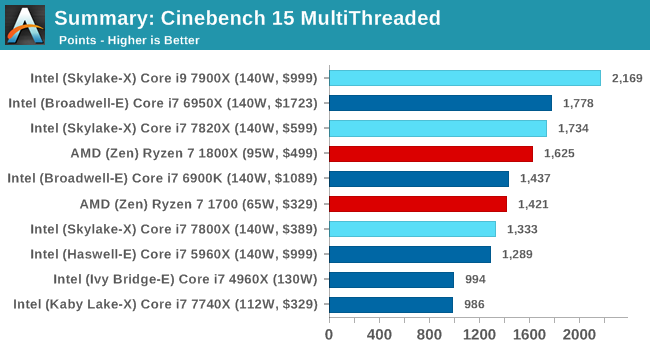
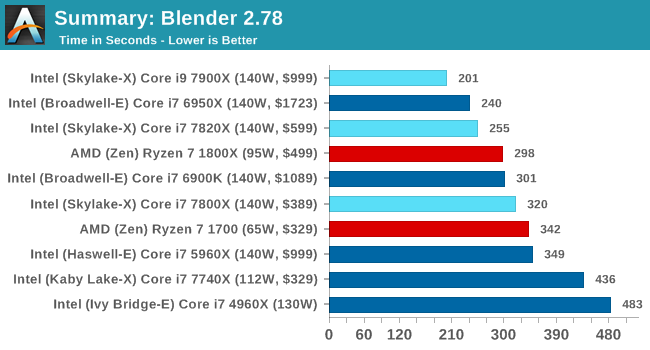
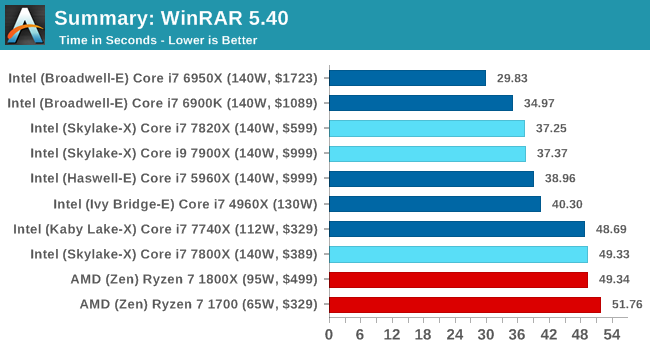
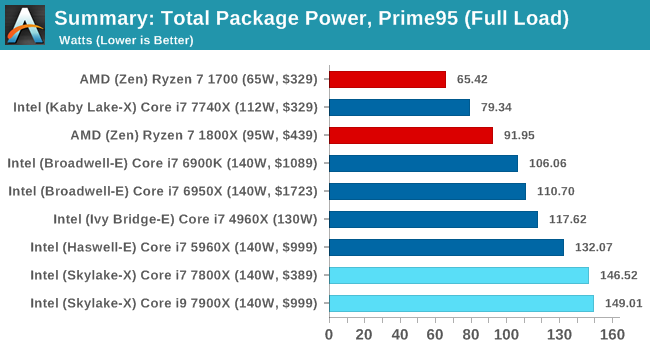
In the end, this is what we get: aside from some tests that are L3 memory sensitive such as DigiCortex, WinRAR, and some of the PCMark8 tests, the Core i9-7900X wins every CPU test. For anyone who was unsure about getting the 10-core on the last generation on a compute basis, this new one seems to be the one to get.
The gaming story is unfortunately not quite as rosy. We had last minute BIOS updates to a number of our boards because some of the gaming tests were super underperforming on the new Skylake-X parts. We are told that these early BIOSes are having power issues to do with turboing, as well as Intel’s Speed Shift technology when the GPU is active.
While these newer BIOSes have improved things, there are still some remaining performance issues to be resolved. Our GTX1080 seems to be hit the hardest out of our four GPUs, as well as Civilization 6, the second Rise of the Tomb Raider test, and Rocket League on all GPUs. As a result, we only posted a minor selection of results, most of which show good parity at 4K. The good news is that most of the issues seem to happen at 1080p, when the CPU is more at fault. The bad news is that when the CPU is pushed into a corner, the current BIOS situation is handicapping Skylake-SP in gaming.
I'm going to hold off on making a final recommendation for gaming for the moment, as right now there are clear platform problems. I have no doubt Intel and the motherboard vendors can fix them – this isn't the first time that we've seen a new platform struggle at launch (nor will it be the last). But with pre-orders opening up today, if you're a gamer you should probably wait for the platform to mature a bit more and for the remaining gaming issues to be fixed before ordering anything.
Itching for 18 Cores?
While today is the launch for Skylake-X CPUs up to 10-cores, a lot of talk will be around the 18-core Core i9-7980XE part due later this year, coming out at $1999. Double the price of the 10-core will unlikely equal double the performance, as we would expect lower frequencies to compensate. But users who need 18 lots of AVX-512 support will be rubbing their hands with glee. It will also be an interesting one to overclock, and I suspect that certain companies are already planning ahead to break some world records with it. We’ll try and get a sample in.
Should I wait for the 12-core? For ThreadRipper? Or Just Go Ryzen?
Both the 12-core Core i9-7920X and AMD’s ThreadRipper parts are set to launch this summer, with the Intel part confirmed in the August timeframe. By this time the X299 ecosystem should be settling down, while AMD will have to navigate a new X399 ecosystem, which I’m getting mixed messages about (some motherboard vendors say they are almost ready, others say they’re not even close). Both of these CPUs will be exchanging more cores for frequency, and the cost is a big factor – we don’t know for how much ThreadRipper or the X399 motherboards will retail for.
Ultimately a user can decide the following:
- To play it safe, invest in the Core i9-7900X today.
- To play it safe and get a big GPU, save $400 and invest in the Core i7-7820X today.
- To play it cheaper but competitive, invest in Ryzen 7 today.
- To invest in PCIe connectivity, wait for ThreadRipper. 60 PCIe lanes are hard to ignore.
- To invest in AVX512, wait for the next Intel CPUs.
So What’s the Takeaway Here?
From an engineering perspective, Intel is doing new things. The cache, the mesh, and AVX512 are interesting changes from several years of iterative enhancements on the prosumer side, but it will take time to see how relevant they will become. For some enterprise applications, they will make perfect sense.
From a consumer/prosumer perspective, it breaks the mold by offering some CPUs now and some CPUs later. The hardware itself won’t feel too much different, aside from having all the Intel cores and software slowly taking advantage. But Intel’s 10-core, at $999, suddenly got easier to recommend for users in that price bracket. At $599 though, the 8-core saves several hundred dollars for other upgrades if you don’t need AVX-512 or 44 PCIe lanes.


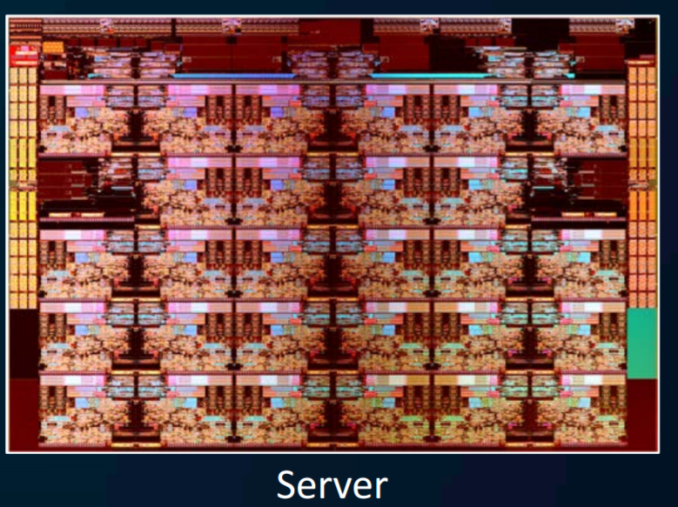
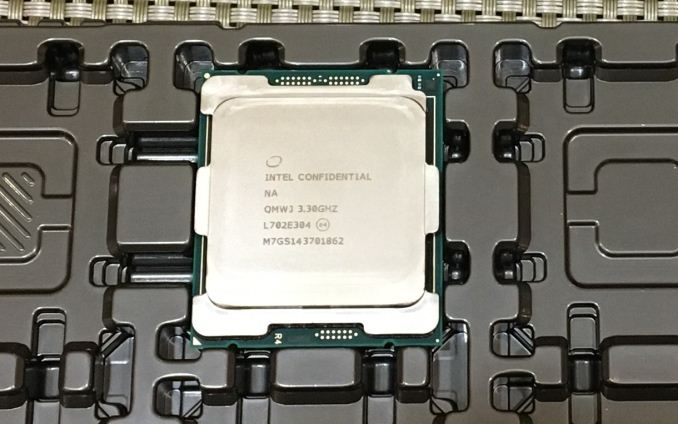








264 Comments
View All Comments
rascalion - Monday, June 19, 2017 - link
Are the Ryzen numbers in the charts retests using the last round of bios and software updates?Ian Cutress - Monday, June 19, 2017 - link
As much as possible, the latest BIOSes are used.Our CPU testing suite is locked in for software versions as of March 2017. This is because testing 30/50/100+ CPUs can't be done overnight, we have to have rigid points where versions are locked in. My cycle is usually 12-18 months. (Note I'm only one person doing all this data.)
FreckledTrout - Monday, June 19, 2017 - link
Ian any chance once there are a few BIOS tweaks you could say do a mini updated review on the 7820x vs Ryzen 1800x. With Ryzen having latest BIOS as well plus 3200Mhz memory. I'm just curious really how the 8-core guys line up when some of the dust settles and I think a lot of people will be.Ian Cutress - Monday, June 19, 2017 - link
Any reason why 3200? I'll have Intel people saying it is pushing the Ryzen out of specjjj - Monday, June 19, 2017 - link
You could do a memory subsystem scaling review for all platforms, Skylake X, Threadripper, Ryzen (Summit Ridge) and Coffee Lake. Cache, interconnect, DRAM. See where they are, how they scale, where the bottlenecks are, single rank vs dual rank modules and perf impact in practice.Why not even impact on power and efficiency.In any case, you'll need to update Ryzen 5 and 7 results when Ryzen 3 arrives , isn't it?
For DRAM at 3200 it might be out of spec - overclocking the core is out of spec too but that has never stopped anyone from overclocking the memory. Right now 3200 is what a lot of folks buy , at least for higher end mainstream Ofc some will argue that Ryzen scales better with memory and that's why it is unfair but it's a hell of a lot more reasonable than testing 1080p gaming with a 1080 TI since it's a popular real world scenario.
At the end of the day the goal should be to inform, not to watch out for Intel's or AMD''s feelings.
vanilla_gorilla - Monday, June 19, 2017 - link
>For DRAM at 3200 it might be out of spec - overclocking the core is out of spec too but that has never stopped anyone from overclocking the memory.This. Exactly. We're enthusiasts and we always push the envelope. No one cares what the specs are all we care is about what these processors are capable of in the right hands.
And Ian I think you guys do an awesome job, there's no other place I look for CPU benchmarks. Keep up what you do, we all appreciate it, as well as your willingness to have a dialog with us about the process. Really cannot say how impressed I am by how open and engaged you are, it's really commendable.
Ian Cutress - Tuesday, June 20, 2017 - link
Thanks for the comments :)Though on your comments about pushing things out of spec. We have a good deal of readers who want plain stock for their businesses - AT isn't solely a consumer focused site. Otherwise I'd just jack all the CPUs and just post OC results :D Our base testing will always be at stock, and for comparison testing there has to be an element of consistency - testing an OC'ed part against a stock part in a direct A vs B comparison is only going to end up with a barrage of emails being rammed down my throat. There has to be some planning involved.
Ian Cutress - Tuesday, June 20, 2017 - link
I've been planning a memory scaling article, I just haven't had the time (this article was around 6 weeks of prep with all the events going on that I had to attend).Note we don't retest stuff every review. With our new 2017 test suite, I've been going through regression testing. Usually regression testing is done once for the full segment until the benchmarks are changed again. I'll look at my next few months (still stupidly busy) and look at the priorities here.
FreckledTrout - Monday, June 19, 2017 - link
Most people can easily buy a 3200 kit for not a lot of extra money. It doesn't take a lot tweaking(well not anymore on AGESA 1.0.0.6) or silicone lottery like an OC, just a bit more cash. From what I have seen with Ryzen it is the sweet spot on price and performance. I would assume Its likely the most chosen configuration on the R7's. To make it fair use 3200 on the 7820x as well. I only ask because Ryzen did way better than I would have thought and would like to see it with 3200Mhz memory and latest updates to see really how close Intel and AMD are on 8-core systems. Then im going to build :)tipoo - Monday, June 19, 2017 - link
Launch review! Nice work dude(s).